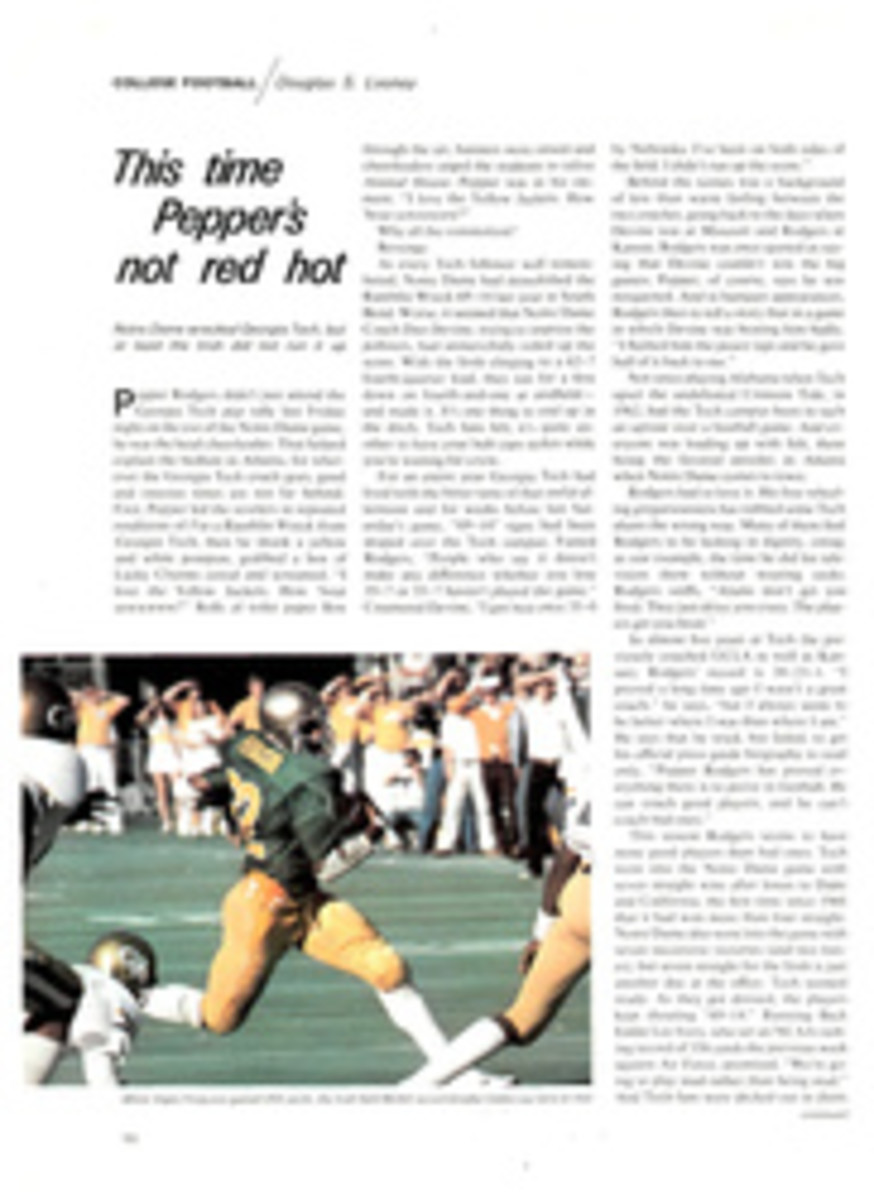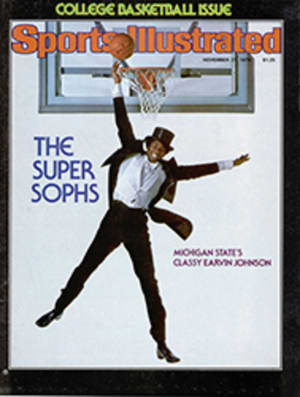
KEANEY INVENTED THE FAST BREAK AND RHODE ISLAND MADE THE BIG TIME
By an extraordinary coincidence, the field of the 1978 NCAA basketball championship tournament included schools which were once coached by four of the men who have done the most to shape the modern game: Kansas, Kentucky, UCLA and Rhode Island.
Rhode Island mentioned in the same breath as three superpowers of modern basketball? Even the casual fan is at least acquainted with the legends of Phog Allen, Adolph Rupp and John Wooden. But who, he might ask, was Frank W. Keaney. Well, Keaney of Rhode Island probably did more than any other coach to transform basketball into a running game emphasizing speed and stamina. It was Keaney who originated the fast break, which revolutionized the game of basketball as much as the forward pass changed football.
In 28 years at Rhode Island, Keaney had a 403-124 record, but those numbers scarcely measure his achievement. He turned a game of patterned plodding into 40 minutes of frenzied excitement while overflow crowds howled their approval. In an era when most teams scored barely 40 or 50 points a game, Rhode Island averaged nearly 80. In 1939 the Rams routed the University of Maine 100-56, and a year later they romped over Connecticut 102-81 in what was at the time the highest scoring college game ever played.
"Our won-loss record wasn't what drew people," says Earl Shannon, a Rhode Island star in the early '40s. "It was our two points a minute." Rodman Gym was packed for every home game, and the Rams filled rival arenas as well. In 1940 they drew 15,590 in their Madison Square Garden debut and they attracted 18,341 when they returned to New York to play in the National Invitational Tournament.
A portly, wide-faced Irishman, Keaney belonged to the old-fashioned school of coaching that stressed character over technique. "My psychology of it is that you've got to feel victory to win," he declared.
"As far as techniques of the game, he was probably the worst coach I ever had," says Ernie Calverley, who played for Keaney from 1942 to 1946 and was his most celebrated player, still renowned for his 58-foot shot against Bowling Green in the 1946 NIT quarterfinals. "But as far as being able to psych the team up for games, he was super. He had a great way with all his players, from substitutes to stars."
Keaney also had a restless imagination and a flair for showmanship. The fast break was only the most spectacular product of his maverick genius; there was a touch of originality in everything he did. A native of Boston, Keaney graduated from Bates in 1911 as a Phi Beta Kappa. He played professional baseball and coached high school sports before Rhode Island hired him in 1920 as athletic director, coach and chemistry instructor. He worked hard, coaching several sports at the small state college and using his chemistry laboratory to concoct liniment and athlete's foot preparations. He even produced a light-blue dye, known as "Keaney blue," which replaced the school's official color, royal blue, on team uniforms.
In football, basketball and baseball Keaney's teams lacked size and numbers. "We had so few people on the football team," recalls Bob Lepper, who played in the '30s, "that the right side of the line had to scrimmage against the left side." To compensate, Keaney stressed conditioning, seeking both to outlast opponents and to minimize injuries. His players were expected to play every minute of the game. "You aren't in shape unless you can run around the bases, stand on home plate and whistle Yankee Doodle," he informed the baseball team. To the injured he proclaimed, "You can't be hurt at Rhode Island; it's against the rules."
While stamina kept his outnumbered players in the game, Keaney's ingenuity made them winners. Impatient with the conservative style of play then in fashion, he searched for ways to open up the games. His baseball teams ran opponents dizzy. In football he was one of the first to use the double-wing, running it with double and triple laterals that flabbergasted coaches who regarded a thrown football with the same apprehension they would a live grenade. The fast break was the logical extension of this impulse to basketball.
Keaney installed an offense geared to quick passes after each center jump or rebound. To verify his premise that "if we shoot more, we'll make more," he kept careful charts of all shots taken. His 1928-29 team (15-1, 41 points a game) was the first to earn fame as a "point a minute" team, an average that rose steadily in succeeding years. When the center jump after each basket was eliminated in 1937, Keaney unleashed the fast break in earnest, and Rhode Island's 1937-38 team raced to a 19-2 record while averaging a national-record 67.3 points a game.
The system was deceptively simple. Rhode Island came out with a full-court man-to-man press and stayed in it the whole game. "A 40-minute press all over the floor was unheard of in those days," says Calverley. "He never played zone, never changed defense. The idea was to have his team in first-class condition and wear out the opposition. We didn't take time-outs. When the other team did, he didn't allow us to sit down."
Whenever a Ram player got his hands on the ball after an opponent's basket or in the back court, he heaved a long pass to a breaking teammate. "The idea was to beat them down the floor in numbers," Calverley adds. That was the offense; everything else was improvisation. "We had no patterns or set plays," Shannon says, "we just got the ball down fast. Keaney's theory was that if you shoot more times and maintain the same average, you win games. It was organized disorganization."
Keaney did more than do away with the traditional pattern offense and zone defense. The fast break also obliged his players to abandon the two-handed shot. "We had to shoot one-handed, on the run," Calverley recalls. "He used to say, 'Hey, if the music plays faster, you dance faster.' "
Practices consisted of conditioning exercises, scrimmages, free throws, layups and drills in throwing the ball the length of the floor. The Rams also were taught not to dribble. "He hated the dribble, absolutely hated it," Shannon says. "He'd say, 'What are you trying to do, prove there's air in the ball?' " Even in practice his love of the unorthodox surfaced. When his team shot poorly, Keaney installed 15-inch rims inside the regulation 18-inch hoops to sharpen their eye. To prepare them for smoke-filled arenas like the Garden, he filled the Rodman Gym with smudge pots burning the foulest tobacco he could find.
Most teams wilted in the face of the Rhode Island break. Unaccustomed to constant pressure and unable to stand the pace, some resorted to stalling, which brought out the showman in Keaney. Once, when Tufts tried to stall, Keaney dashed onto a stair landing and led Rhode-Island students in the school song. Maine, trailing by six points, tried to counter the break with a tight zone; Keaney responded by having four of his players read newspapers while the fifth held the ball. When Brown used the same stalling tactic, Keaney ordered Calverley to literally sit on the ball for the last eight minutes of the half. At halftime Keaney charged up to the Brown coach and barked, "You're ruining the game of basketball. You're behind and are supposed to force the issue. You're content to lose. Sonny, you're a born loser!"
Few schools dared to run with the Rams. Teams could beat Rhode Island by slowing the tempo and controlling the boards, but even with superior ability that was never easy. Though the Rams often lacked the talent and depth of their rivals, Keaney took them to four NIT tournaments. In 1946 they even reached the finals, losing to mighty Kentucky by a single point. Against stronger teams the fast break served as an equalizer, a strategy for keeping Rhode Island in even the toughest games. "He won many games he had no license to win," observes Dr. Harold Browning, a former Rhode Island dean.
Keaney's blitzkrieg approach to the game sometimes got his teams in foul trouble. In one game, in which the Rams were left with four players, he shoved a chair onto the floor and told a startled official, "Here's my fifth player. Let's get on with the game." In an NIT game against DePaul, he sent Mike Santoro, a 5'4" forward, to jump center against 6'9½" George Mikan. Predictably, rival coaches were not always amused by these antics. Some regarded Keaney as a heretic. Others resented him because, as Shannon suggests, "I don't think he was averse to running it up, to maintain our scoring average."
In reply, Keaney, at a luncheon in New York, advised his fellow coaches to "give the crowds action. If some coach puts up a screwy defense, use a screwier offense. Then if you lose, pivot and go home." To critics of his style he said simply, "We don't say we're right, but you have to stop us."
Keaney retired in 1947, leaving an imprint on the game that, curiously, went largely unrecognized. It was not until 1960, seven years before his death, that Keaney's contribution was formally acknowledged by his election to the Basketball Hall of Fame. In personal terms he gave his players what he gave basketball itself. Earl Shannon put it best: "As a motivator he was way ahead of his time. He made it fun to play the game."
ILLUSTRATION

